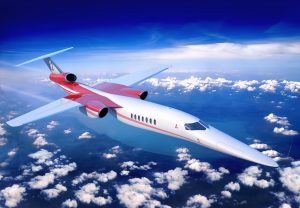If aerospace is experiencing a second “golden age,” as some industry professionals claim, credit in part the development of a civil supersonic airplane—probably a business jet initially—to satisfy the appetite for reduced journey times and enhanced global mobility.
While such an aircraft almost certainly will make its debut by the mid-2020s, long-term market acceptance will hinge on achieving environmental sustainability both in terms of noise and emissions. As it turns out, significant progress is being made on both imperatives.
Problems of sonic boom and airport noise effectively are what killed the Anglo-French Concorde in the early 2000s. Since then, aircraft developers competing to bring the first sustainable supersonic civil airplane to market have been leveraging enabling technologies in design, propulsion, aerodynamics and systems that were either not previously available or not sufficiently advanced.
“We now have the technology to dramatically reduce the impact of those sonic booms that were completely unacceptable from the Concorde,” said Michael Buonanno, air vehicle lead for the Lockheed Martin X-59 low-boom demonstrator for NASA.
The newest version of the sharply swept-wing, quiet SST design is on track to make its first flight in 2021. “Leveraging data from the X-59, regulators may replace the current boom guidelines with standards to which future manufacturers could design, so this could really usher in a new age of commercial transportation.”

While regulators and the International Civil Aviation Organization are still deciding on exact airport noise requirements, Buonanno said the design and propulsion of Lockheed Martin’s SST concept will be capable of meeting whatever guidelines are defined. The aircraft’s 225-ft-long, twin tail-mounted nonafterburning engines are being designed to transport 40 passengers at an optimum speed of up to Mach 1.7 (about 1,300 mph) on transoceanic flights.
To meet future noise restrictions, Lockheed’s concept embraces four key enabling technologies: shaped-boom design, integrated low-noise propulsion, swept-wing supersonic natural laminar flow, and the external vision system for visibility from the cockpit. These are the areas that may have changed the most in the past 10 to 20 years as a result of investments by the government and industry, according to Buonanno. Lockheed Martin is just one of several aircraft manufacturers who are developing aircraft for the civil/commercial supersonic market.
Aviation start-up, Boom Supersonic, aims to bring supersonic travel back to commercial passengers, delivering flights at a cost equivalent to a business-class seat on a modern subsonic airliner. And a recently announced partnership between Boom Supersonic and Dassault Systèmes will advance the design and development of Overture, its Mach- 2.2 commercial airliner, with an aim to make supersonic travel mainstream and affordable.
Aerion Supersonic recently unveiled a finalized design for its AS2 business jet, which it believes is not only sustainable but also lays a solid foundation for a family of follow-on family of high-speed commercial and military derivatives.

Aerion believes the AS2’s new delta wing and revised empennage will boost aerodynamic efficiency and maintain its push toward fully sustainable supersonic operation. As part of its push for sustainability, Aerion is engineering the aircraft to use 100 percent alternative jet fuel to help reduce its carbon footprint.
The aircraft is designed to fly more than 5,000 nm at speeds up to Mach 1.4 (about 1,200 mph). Aerion also will offer a boomless cruise capability up to Mach 0.95 for transcontinental flights of up to 4,200 nm under current regulations.
Of all the companies developing a supersonic civil aircraft, the AS2 by far is the farthest along. Its first flight is scheduled for 2025, with entry into service in 2027. “We’ll be selling [the AS2] into a market that places a premium on speed,” said Matthew Mejia, executive vice president of strategy and chief financial officer. “Time is the one thing you can’t make more of, and that resonates with all of the potential markets we’ve targeted.”
Above all, Mejia noted, Aerion “has a made a real commitment to sustainability, with the ability to operate in both existing and planned regulatory environments.”